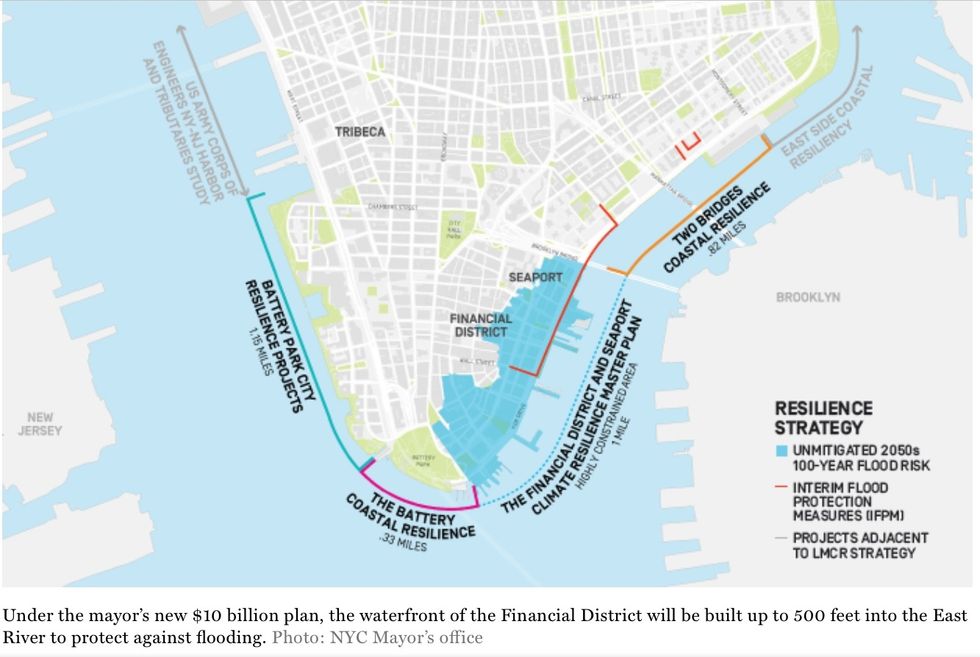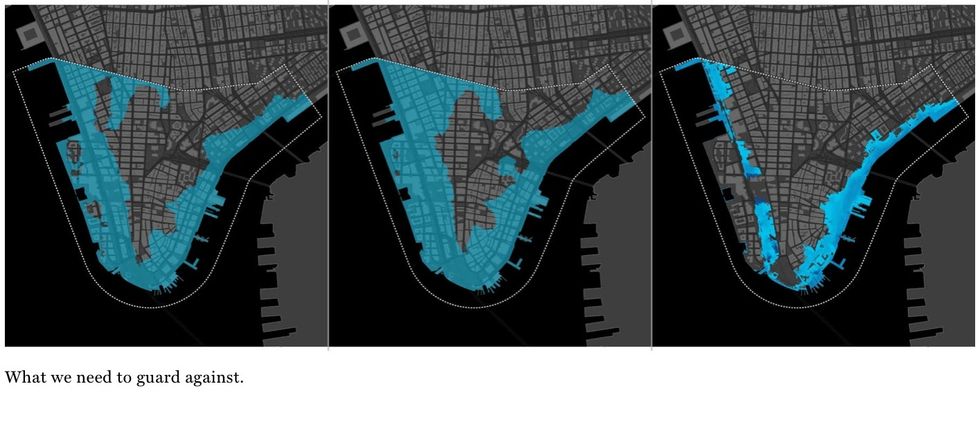Six years ago, Hurricane Sandy slammed into New York City. The storm put 51 square miles of it under water. Seventeen thousand homes were damaged or destroyed. Forty-four New Yorkers lost their lives.
We don't debate global warming in New York City. Not anymore. The only question is where to build the barriers to protect us from rising seas and the inevitable next storm, and how fast we can build them.
On Thursday, I am joining a group of climate scientists and local officials to announce we're filling one of the biggest gaps in our coastal defenses. We're going to protect Lower Manhattan, which includes the Financial District, home to a half-million jobs, 90,000 residents, and the nexus of almost all our subway lines.It will be one of the most complex environmental and engineering challenges our city has ever undertaken and it will, literally, alter the shape of the island of Manhattan.
All across this country, cities are grappling with the same existential threat. But nowhere in the $4.75 trillion budget President Trump just proposed is there anything approaching a plan to protect our coastal cities from rising seas.
This is a national emergency without a national policy. And that has to change.
It's a twisted reality, but big federal dollars to protect our coastlines only flow in the wake of disasters like Sandy. Those investments have helped protect our Rockaway peninsula with new, reinforced sand dunes nearly 20 feet above sea level. Thanks to our congressional delegation, we just announced a new $615 million sea wall that will protect the east shore of Staten Island — another vulnerable area flooded by the storm.
The plan we're announcing will invest a half-billion dollars to fortify most of Lower Manhattan with grassy berms in parks and removable barriers than can be anchored in place as storms approach. But there's one part of this area that will prove more complex, and more costly, to defend than all the others combined.South Street Seaport and the Financial District, along the eastern edge of Lower Manhattan, sit so close to sea level — just eight feet above the waterline — and are so crowded with utilities, sewers, and subway lines that we can't build flood protection on the land. So we'll have to build more land itself.
Over the coming years, we will push out the Lower Manhattan coastline as much as 500 feet, or up to two city blocks, into the East River, from the Brooklyn Bridge to the Battery. The new land will be higher than the current coast, protecting the neighborhoods from future storms and the higher tides that will threaten its survival in the decades to come.
When we complete the coastal extension, which could cost $10 billion, Lower Manhattan will be secure from rising seas through 2100.
We're going to build it, because we have no choice.
This should be as much a national priority as a local one — protecting the global center of commerce, the Federal Reserve, the home to a sector of our economy that touches every town and region in America.
It should be backed by big federal dollars.
It should be put on an accelerated track that shaves years off our decade-long construction timeline by cutting red tape because of the urgency of this crisis.
But right now, cities like New York are facing down the greatest threat to our survival on our own.
I don't expect deniers like President Trump to come to the table on this. It's on Democrats to put this front and center on our national agenda in a way we haven't ever before.
The coalescing agenda represented by the Green New Deal is our best shot. We not only need a rapid transition to a low-carbon economy that prevents the most cataclysmic consequences of global warming, we need real dollars and real planning for coastal protection to combat the consequences that are already inevitable.
We need a Green New Deal that marches forward on both these fronts at the same time, and with equal urgency.
This is infrastructure, just as vital as roads, rails, and bridges. It's national security, just as critical to keeping people safe as any military hardware. Preparing for climate change has to be a national priority, backed by tens of billions in federal investment. Lives are on the line.The reason we're forced take dramatic action now is because for years so many in Washington put the profits of Big Oil over the future of our planet. New York City is divesting our pension funds from the fossil-fuel companies who caused this crisis and we're suing them for refusing to act when they knew the damage it would cause to cities like ours.
Now, New York doesn't have a choice but to prepare for what's coming. Neither does Miami, Houston, Charleston or any of the coastal cities facing an existential threat to their future.
Time is not on our side. This country has wasted too many years pretending it had the luxury of debating climate change.
The national emergency is already here. We have to meet it head-on. And we need Washington behind us.
Bill de Blasio is mayor of New York City.
New York mag, March 14, 2019
###
Voices4America Post Script. I am not a Bill DeBlasio supporter. I don't know if the plan he proposes is effective and right. I do know Cities and America must ACT NOW to combat the damage #ClimateChange threatens. Read the plan. What should your city do? #GreenNewDeal #ActNow



